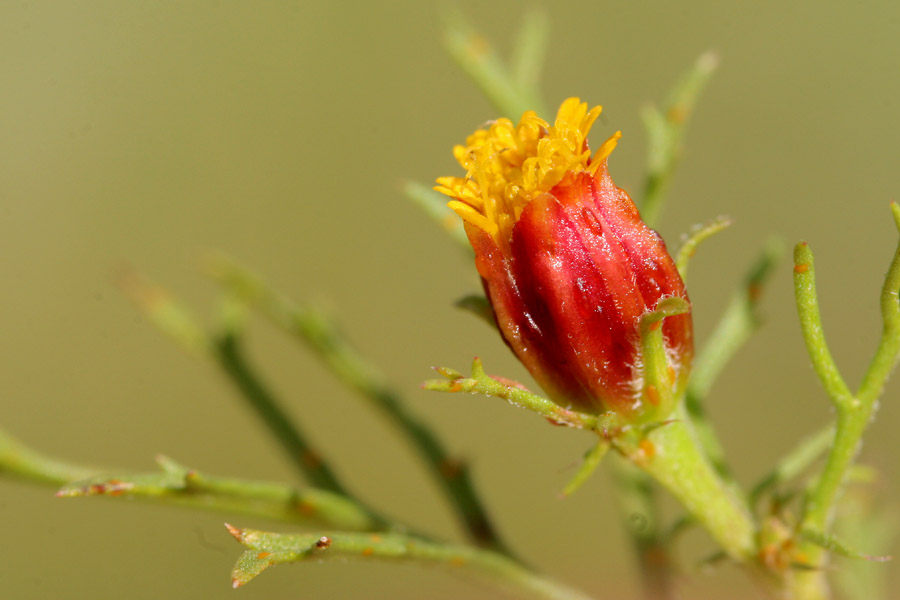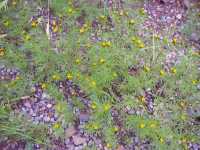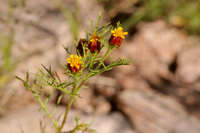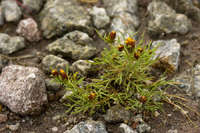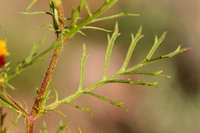|
|
|
|
Family: Asteraceae
fetid marigold
[Boebera papposa (Vent.) Rydb., moreTagetes papposa Vent.] |
Leaves 15-50 × 10-40 mm overall, ultimate lobes (7-)11-15, 5-20 × 1-3 mm, glabrous or sparsely hairy, dotted with oil-glands. Peduncles 1-5(-10) mm. Involucres 6-10 mm. Phyllaries each bearing 1-7 oil-glands. Ray laminae 1.5-2.5 × 1-2 mm. Disc corollas ca. 3 mm. Cypselae3-3.5 mm; pappi 1-3 mm. 2n = 26. Flowering summer-fall. Grasslands, open woodlands, often ruderal, fields, along roadways; 0-2000 m; Ont.; Ariz., Ark., Calif., Colo., Ill., Ind., Iowa, Kans., Ky., La., Maine, Mass., Mich., Minn., Mo., Mont., Nebr., Nev., N.H., N.Mex., N.Y., N.Dak., Ohio, Okla., Pa., S.Dak., Tenn., Tex., Utah, Vt., W.Va., Wis., Wyo.; Mexico; Central America; introduced in South America. Much branched, malodorous annual 1-4 dm, puberulent or subglabrous; lvs 2-4 cm, pinnatifid or bipinnatifid, the ultimate segments linear or filiform; heads numerous, campanulate, the disk 4-10 mm wide; invol 6-8 mm, the outer bracts linear, subherbaceous, 2/3 as long as the broader and more chartaceous inner, which are weakly joined at base; rays few, inconspicuous, erect, orange-yellow, 1-2 mm; receptacle pitted, slightly convex; style-branches truncate; pappus scales ca 20, deeply divided into 5-10 bristles; 2n=26. Dry open places, often weedy; w. U.S. to s. Mex. and intr. e. to N.H. and Tenn. July-Oct. (Boebera p.) Gleason, Henry A. & Cronquist, Arthur J. 1991. Manual of vascular plants of northeastern United States and adjacent Canada. lxxv + 910 pp. ©The New York Botanical Garden. All rights reserved. Used by permission. FNA 2006, Wiggins 1964, Kearney and Peebles 1969 Duration: Annual Nativity: Native Lifeform: Forb/Herb General: Strongly scented annual herbs, 5-70 cm tall; stems erect to decumbent, often much-branched, glabrous or somewhat woolly-pubescent. Leaves: Opposite below, becoming alternate near the top, sessile; blades 2-5 cm long, once or twice pinnately divided into narrowly linear segments, scattered with conspicuous translucent to orange oil glands. Flowers: Flower heads numerous, obscurely radiate, sessile or on stalks up to 3 cm long, borne singly or in clusters of 2 or 3; calyculi (extra set of bracts subtending the involucre) of 1-9 linear bractlets, these gland-dotted and a bit shorter than the phyllaries; involucre (ring of bracts wrapped around flower head) turbunate to campanulate, 6-10 mm high, the bracts (phyllaries) oval-oblanceolate, red-orange, and gland-dotted, in 2 series and united near the base; ray florets mostly 5 or 8, the lamiae (ray petals) inconspicuous, orange-yellow, to 2 mm long; disc florets 12-50, yellowish. Fruits: Achenes about 3 mm long, topped with a pappus of palea and bristles, in 2 unequal series, about 3 mm long. Ecology: Found in dry sites, roadsides, old fields and disturbed areas, from 3,000-7,000 ft (915-2135 m); flowers August-October. Distribution: Throughout the US, except for the Pacific Northwest and the Southeast. Notes: Look for an annual plant with herbage dotted with glands that are often orange but sometimes translucent; leaves pinnately divided into linear lobes; and narrow orange flower heads, the ray petals barely noticeable, only 1-2 mm long. The distinctive glands make this plant hard to mistake for any other in our range. Other common species traditionally placed in the genus Dyssodia are D. acerosa (now Thymophylla acerosa) and D. thurberi (now Thymophylla pentachaeta). Both those species are perennials and have yellow flowers with ray florets that are much more distinctive. Host plant for Dainty Sulphur butterfly. Ethnobotany: Western Keres make an infusion for fevers, and smoke the plant to treat epilepsy; Ramah Navajo make a poultice for ant bites; various tribes use the plant to treat headaches, coughing, and difficulty breathing; Apache ground seeds for flour, and used the leaves as a seasoning. Etymology: Dyssodia is from the Greek dysodia for disagreeable odor, while papposa is from the Latin for with pappus. Synonyms: Boebera papposa, Tagetes papposa Editor: SBuckley 2010, AHazelton 2015, AHazelton 2017 |


